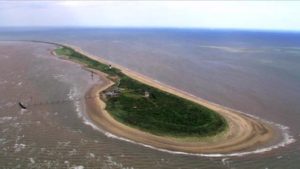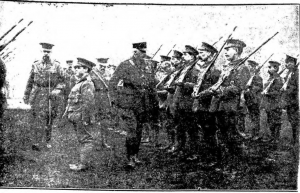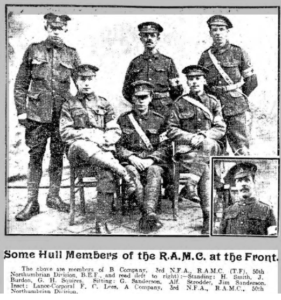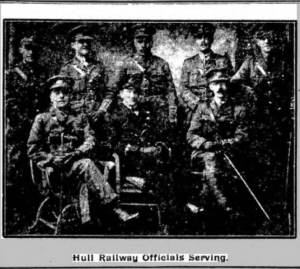Four Volunteer battalions were raised by Lord Lieutenant & Colonel, W Lambert White, to release regular soldiers for overseas service. (Two for Hull and two for East Riding). These were formed by men too old for active service on 4th August 1914 and disbanded when the war ended.

- The 1st Battalion formed themselves into a ‘Rifle Club’ to defend against invasion.
- The 2nd Battalion was comprised mostly of members from Hull’s Golf Clubs and enrolled themselves as ‘Special Constables’ under Mr G Morley, the Chief Police Constable.
- The 3rd Battalion was formed August 1914 in Beverley. A training unit, it remained in the UK throughout the war. The 3rd Battalion moved within a few days of declaration of war to Hedon, for duty at the Humber Garrison. It then made the short journey in April 1916 to Withernsea.
- The 4th Battalion was financed by Messrs Watson, of Olympia Oil Mills. It was formed in Hull on 8th April 1916. In September 1916 they moved to Catterick. In 1917 they moved to Hornsea and by November 1918 they went to South Dalton, as part of the Humber Garrison.
- A 5th ‘Cyclist’ Battalion was formed at Park Street in Hull in August 1914. and was used for Home Defence along the East Coast.
- Hull formed a Railway ‘Pals’ Battalion, know as the 17th Northumberland Fusiliers in September 1914. This occupied two, large warehouses at Hull’s King George Dock, and recruited from all the North Eastern towns, along the Hull and Barnsley Railway line. The battalion moved to Catterick in June 1915 and then embarked for Albert, in France, in November 1915. The battalion took part in the opening battle of the Somme at Thiepval and saw much action throughout the war.
-

The East Riding Yeomanry Badge The 1st/1st East Riding Yeomanry (ERY) was a Territorial Cavalry regiment originally set up after the Boer War (1899-1902) to address the shortage of good quality mounted troops in the British Army. The intention was to create a 4 squadron regiment of around 30 officers and 566 men. The ERY was recruited locally and divided into four squadrons, designated A, B, C and D, along with a machine gun section. They were based at Hull, Beverley, Fulford (near York) and Bridlington respectively. The term ‘Yeoman’ originally meant a moderately well-off, independent, farmer. A yeomanry regiment was a natural choice for a farmer, used to working with horses. Recruits enlisted for 4 years, which included a minimum of 16 days training a year, at different camps each year. Many of the original ERY officers had previous military service with the regular army, including in the Boer Wars and India. Officers tended to be landowners, of sizeable country estates, such as Escrick, and Hotham Hall; others were the sons of wealth businessmen, like the Wilson shipping family in Hull. The selection of the running fox as the regimental emblem – seen on its collar badges and buttons – reflected the hunting and shooting aristocracy who very largely made up the original officer complement. Prior to war the 1st/1st EYR recruited largely from Hull and East Riding. It included many fathers, sons and brothers, “servants” of local landowners and men from the same Hull workplaces. Bonded together by social events and sporting competitions, the EYR had very much a family feel.
- The East Riding Yeomanry regiment was mobilised in August 1914, but then spent a year on coastal defence and training. From mid-1915 onwards, the force was expanded and men were recruited for the 2/1st and 3/1st Yeomanry. These tended to be elderly or under fit men recruited for basic patrolling and guarding camps. They trained in Hull and Beverley, and at Seaham Hall in County Durham, In autumn 1915, at Costessey near Norwich, there was a call for volunteers to go on active service (this was required at the time, as Territorials had not originally signed up for service overseas). The 2/1st men ended up being transferred to other regiments for service on the western front. Of these, the most common transfer seems to have been to various battalions of the East Yorkshire Regiment, particularly the 8th and 11th, as well as the King’s Own Yorkshire Light Infantry, especially the 1/4th battalion.
- The ERY was posted to Egypt in September, 1915. They were stationed with the British Army in Egypt with the task of defending the Suez Canal from Ottoman troops and later of advancing against the Turks. (The Suez Canal in Egypt connects the Mediterranean Sea with the Red Sea and enables ships to travel between Europe and East Asia without having to navigate around Africa. It was a vital supply route for the British Empire. Some people at the time believed that success in Palestine would be a better way to defeat Germany than the stalemate on the Western Front.) In 1915 the East Riding Yeomanry sailed for Macedonia, but the destination was altered and in November they landed in Egypt. They spent most of 1916 in the Fayoum oasis, guarding against possible attacks on caravan routes by a troublesome local tribe – the Senussi – who had pro-German sympathies.

Spurn Point juts 3.5 miles (6km) into the North Sea and guards entry to the ports of Hull, Grimsby and Goole.
Defence installations on the point date back to the Napoleonic Wars, in 1805. When World War One was declared on 4 August 1914, military activity expanded and came to dominate the area. Within 12 hours, the village of Kilnsea at the top of the peninsula found itself home to a garrison of more than 500 troops.
As the war continued further defences were built along Spurn Point. These trenches, gun emplacements and other bases were then linked by a narrow gauge railway line. A WW1 concrete “Acoustic Mirror” used to detect Zeppelins still stands in a field near Kilnsea. Two large circular forts were also built in the Humber estuary; Bull Sand Fort and Haile Sand Fort.The 1st /1st ERY became part of the Western frontier force in Libya, before being transferred to Palestine in 1917. From March until October 1917, they fought the 1st and 3rd battles of Gaza, and in November they advanced into the Judean Hills to cut off Jerusalem from the north. At El Mughar in November 1917 the East Riding Yeomanry was involved in one of the last cavalry charges of the British Army. The Machine Gun element of the 1/1st ERY remained in the Middle East for the duration of the war as part of the Machine Gun Corps (Cavalry), whilst the rest of the regiment was transferred to the Western Front in France in May 1918. They then became 102nd (Lincolnshire and East Riding Yeomanry) Bn, The Machine Gun Corps. There they served as something of a fire fighting force, supporting a number of assaults on German lines in the Cambrai/Valenciennes area until the Armistice in November 1918. Most of the ERY were demobilised and sent home within a few months of the end of hostilities. After the Great War the Yorkshire Hussars and Dragoons reformed as cavalry regiments, forming the 5th Cavalry Brigade together with the Sherwood Rangers Yeomanry. The East Riding Yeomanry rerolled to form the 26th Armoured Car Company of the Tank Corps.
In all, around 237 ERY men died or were killed during the war, including those who had transferred to other regiments (and also some non-military deaths at home). Of these, around 40 deaths occurred in the Middle East theatre and nearly 30 as a result of the sinking of HMT Arcadian in the Aegean in 1917 and the RMS Leinster in the Irish Sea in 1918, both by German U-boats. The regiment had certainly ‘done its bit’ and proved as tough as any regular army unit.
The 1st Hull Heavy Battery was recruited from Kingston upon Hull. It was the first unit of the Royal Garrison Artillery raised for ‘Kitchener’s Army‘ and it went on to serve as a howitzer battery in the East African Campaign and as a siege battery on the Western Front. In September 1914, Lord Nunburnholme who was simultaneously raising the ‘Hull Pals’ Brigade (10th–13th Service Battalions of the East Yorkshire Regiment), also raised the 124th (2nd Hull) and 146th (3rd Hull) Heavy Batteries and the 31st (Hull) Divisional Ammunition Column. Lord Nunburnholme borrowed Hull City Hall and opened it on 6 September as the Central Hull Recruiting Office for all the units being raised in the city. Douglas Boyd, a Hull Corporation employee, was commissioned as Lieutenant and appointed recruiting officer. By 15 September, 80 men had been enrolled for the battery, many drawn from the shipbuilding and engineering firms in Hull, while drivers came from the rural villages of the East Riding. It reached its full war establishment by mid-December, when it was authorised to recruit an additional depot section to supply reinforcements.

3,000 men from the East Yorkshire Volunteer Brigade, parade in Hull, December 1915. Note the small soldier standing at the front. The recruits began training at East Hull Barracks on Holderness Road, performing drill in nearby East Park. The men lived at home, and until uniforms arrived the men of 1st Hull Batteryy were distinguished form the other East Riding recruits by wearing a red and blue armband on their civilian clothes. The battery’s guns, four Boer war -era 4.7 inch guns, arrived at Kingston Street Station in late October, and the men dragged them through the streets of Hull, first to Wenlock Barracks, then on to East Hull Barracks.
On 5 November, Captain Williams handed over command and reverted to the RNR (he commanded armed merchant vessels later in the war). The new CO was Temporary Captain, John McCracken, who had been an RGA Battery Serjeant-Major with 23 years’ experience at the outbreak of war. As part of 11th Division, the battery was formally designated 11th (Hull) Heavy Battery on 1 May 1915, when it established its headquarters outside the city at the former Hedon Racecourse. Here the horse teams were lodged in the racing stables and the battery began serious training. A typical RGA company was commanded by a major with 6 or so officers, around 10 NCOs and 100 to 200 men. The uniform of Garrison Artillery was the same as Field Artillery except that they were more likely to wear trousers instead of boots and breeches. On their shoulder straps were the initials of the name of their Division and the number of their company.

Hull RAMC Members
Recognising the threat of coastal attack, £17,600 was raised through public donations to arm, and equip the 4 Volunteer Battalions. Hull and East Riding Councils both subscribed £1000 each.
Hull City Council also provided another £1,000 to the 2nd Battalion in recognition of the work done by the Special Constables. This money purchased 2,800 Martini Henry Rifles and 100,000 rounds of ammunition plus green and grey uniforms. This was at a time when most other regiments in the UK were drilling with wooden rifles and casual clothes. By March 1917 they had received the latest rifles, machine guns and all necessary mobilization stores.
Hull also formed its own Army Service Corps in 1915, the only City to do so. This was furnished with horses and vehicles lent by patriotic merchants. The magnificent stamp of horses was especially commented on by Field Marshall French at his inspection of the Corp in April 1917.

An Anti Aircraft Unit was the last Unit to be raised in Hull and was recruited in 14 days. It was staffed by reliable Officers, over Military age, and who had seen action. They were formed to combat the threat of Air Raids, particularly after the terrifying Zeppelin attacks on Hull. Again, Lord French congratulated the Brigade and particularly the efficiency of Section B men compared with others in Britain.
These reserve Battalions were trained in Holderness by Special Instructors and drilled in musketry, bayonet fighting and bombing. Each Volunteer Battalion was assigned a defined role and place in times of invasion. Night Coast Patrol work was performed during several months in 1916 and three critical months in 1918.
The East Riding Royal Garrison Artillery was a Hull-based RGA. It formed two field batteries and an ammunition column in the 2nd Northumbrian Brigade, RFA, and a separate East Riding RGA (ERRGA) with four companies of coast defence artillery. The East Riding RGA shared Londesborough Barracks in Park Street, Hull, with the 1st and 2nd East Riding Batteries and the ammunition column of the 2nd Northumbrian RFA and other Territorial units. The East Riding RGA’s wartime role, together with other Territorial and Regular RGA units, was to man guns defending major ports on the North East Coast of England, which it carried out during the early part of World War I in the Humber Garrison under No 15 Coastal Fire Command (Spurn Point) and No 16 Coastal Fire Command (Hull). Although the existing battery at Fort Paull was disarmed as the war progressed, a number of new batteries were established to defend the Humber Estuary, so that by April 1918 the dispositions of the Humber Garrison were as follows:

- Sunk Island Battery – 2 x 6-inch Mk VII
- Stallingborough Battery – 2 x 6-inch Mk VII
- Killingholme Battery – 2 x 12-pounder QF
- Green Battery – 2 x 9.2-inch Mk X
- Spurn Point Battery – 2 x 4-inch QF
- Haile Sand Battery – 2 x 4-inch QF
- Godwin’s Battery – 2 x 6-inch Mk VII
As the war progressed, ERRGA coastal units supplied trained manpower to batteries raised for other purposes. The RGA opened a Siege Artillery School in the Humber Garrison and the ERRGA manned 77th and 164th Siege Batteries, RGA. By the end of 1916 most of its remaining gunners had been mobilised to man anti-aircraft batteries.

The 77th ERRGA was largely comprised of Hull men, and saw extensive action on the Somme, Ypres and Cambrai. The 164th Siege Battery, RGA, was raised from the Humber Garrison on 23 May 1916, and disembarked in France on 4 September. It was equipped with four 6-inch (26 cwt) Howitzers. The battery joined 5th HAG with Second Army on 11 September 1916, moving to 1 HAG with Reserve Army on 4 October 1916, during the Battle of the Ancre Heights amd Vimy Ridge. The ‘heavies’ as they were known, were principally employed on harassing fire on the roads used by the retreating enemy and concentrations of fire on HQs and exits from villages.
A memorial plaque was placed in Holy Trinity Church, Hull, in 1960 to mark the centenary of the East Yorkshire Artillery Volunteers. Its full wording is:
“THIS TABLET WAS PLACED HERE TO MARK THE CENTENARY/ YEAR IN 1960 OF THE FORMATION OF THE EAST YORKSHIRE/ ARTILLERY VOLUNTEERS AND IN RECOGNITION OF THE/ FAITHFUL AND GALLANT SERVICES OF THOSE CITIZENS OF/ KINGSTON UPON HULL AND OTHERS WHO SERVED IN PEACE AND/ WAR AS ARTILLERY MEN IN THE UNDERMENTIONED REGIMENT/ 3RD EAST YORKSHIRE ARTILLERY VOLUNTEERS 2ND EAST YORKSHIRE ARTILLERY VOLUNTEERS 2ND EAST RIDING OF YORKSHIRE/ RGA VOLUNTEERS 2ND NORTHUMBRIAN BRIGADE RFA T.F. EAST RIDING RGA T.F. 77TH SIEGE BATTERY RGA T.F./ 165 SIEGE BATTERY RGA T.F. 251ST BRIGADE T.F. 73RD NORTHUMBRIAN FIELD BRIGADE RA T.A. EAST RIDING HEAVY/ BRIGADE RA T.A. 62ND HEAVY A.A. REGIMENT RA T.A. 422 EAST RIDING COAST REGIMENT RA T.A. 462 MIXED HEAVY/ A.A. REGIMENT RA T.A. 676 A.A. REGIMENT RA T.A. 440 HUMBER LIGHT A.A. REGIMENT RA T.A.”
A study of the Official Volunteers list shows that out of 88 Counties providing volunteers, Hull and the East Riding furnished 5 Specialist Units. Northumberland, Durham and the Cities of Edinburgh and Dundee came next with four each. Eight others only had 3 units. This was another great achievement for the City of Hull.
